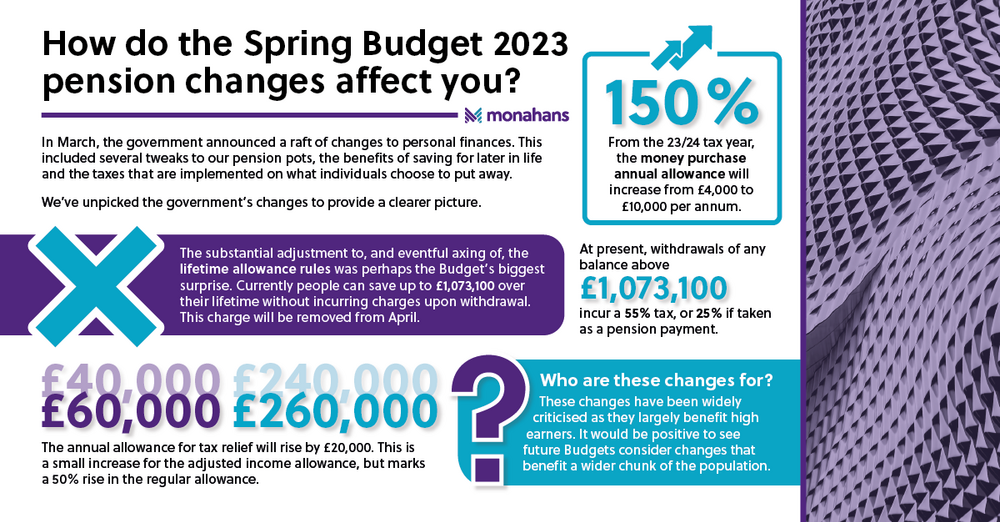14 Apr 2023
What the budget changes mean for your pension stockpile?

As with any budget announcement, there is always lot of information to unravel. At Monahans we are here to help you to understand which changes are relevant for you and your pension, breaking down each element and ensuring that your decisions enhance your ability to save for the future, rather than hinder
In March 2023, the government announced various measures in connection with pension savings. We give a snapshot of the key measures below:
Annual Allowance Increases
From 6th April 2023 the annual allowance for tax relief on pension savings in a registered pension scheme will increase from £40,000 to £60,000 (gross). The adjusted income limit will also increase from £240,000 to £260,000. This means that if a member's adjusted income is over £260,000, their annual allowance in the tax year will be tapered away by £1 for every £2 of adjusted income received over this amount.
Adjusted income includes employment income, pension receipts, interest, dividends, and most other sources of income, together with employer pension contributions.
The minimum tapered annual allowance a member can have from the 2023/24 tax year onwards is now £10,000 (gross) – an increase from £4,000 (gross). This was a welcome reversion, having been £10,000 prior to 5th April 2020, and will again encourage higher earners to continue saving for the future.
It may be possible for individuals to carry forward unused annual allowances from the previous three tax years to enable them make larger pension contributions, however lower historical and tapered annual allowances will still need to be taken in to account when calculating these. An individual’s total gross pension contributions over their annual allowance will incur a tax charge at their highest marginal rate of tax.
Money Purchase Annual Allowance.
For the tax year 2023/24 onwards, the money purchase annual allowance limit will also increase from £4,000 to £10,000 (gross).
Once an individual starts drawing down from a defined pension scheme, a separate money purchase annual allowance limit applies to any further pension contributions they make. This has also been uplifted from £4,000 to £10,000 (gross) to match the minimum tapered annual allowance.
The Lifetime Allowance Surprise
A surprising announcement in the budget for many were the substantial changes made to the Lifetime Allowance (LTA) rules. The LTA is the total amount an individual can have in all registered pension schemes without incurring additional tax charges and was previously set at £1,073,100.
Where an individual receives distributions from their pension scheme after age 55, they can take up to 25% of the funds within their available lifetime allowance free of tax, this is known as the Pension Commencement Lump Sum (PCLS). From 6th April 2023, this amount has been capped at £268,275 for individuals without relevant pension protections.
Previously if there were any remaining funds over the lifetime allowance, a 55% tax charge applied where amounts above this threshold were withdrawn as a lump sum, or at 25%, plus an individual’s marginal rate of tax, if taken as a pension. The government has announced that the LTA charge will be removed from 6th April 2023, and fully abolished from the 2024/25 tax year through a future finance bill.
So, who will these announcements impact?
These changes are likely to benefit the highest earners, those with generous company pensions, or those wanting to substantially increase their pension pot. Owners of established small businesses might also fall into this category having previously focused on growing their businesses rather than funding their pensions.
Needless to say, a pension pot reaching over a £1 million is a distant dream for many workers, however for those that it does impact, this is hugely beneficial.
The implications of the changes to the money purchase annual allowance are also noteworthy. Previously, if someone has retired and requires a lump sum of money, they could draw down from their pension, but would be very much restricted on putting anything back into the pot.
Therefore, the relaxation of these constraints may encourage people back to work so that they can continue to bolster their pension fund.
Looking Forwards
In future budgets it would be positive to see measures designed to benefit a wider range of the population. For instance, people who don't have relevant earnings can currently only personally make contributions of up to a maximum of £3,600 (gross) per annum into their pension pot and this limit has not changed for many years.
An increase would benefit those who are not currently in work because they are in between jobs or are a stay-at-home parent or carer or those whose whole income isn't from relevant earnings but received from a property portfolio. An increase would allow them to receive fair relief and continue to grow their pension pot.
Whether or not you're impacted by the changes in the budget we would always advise our clients to regularly view their pension options, ensuring that they are maximising all limits and allowances available to them, so that they can save effectively for later life. If you want to talk through your pension options, state pension entitlement or receive advice on how to navigate these recent changes, contact me or one of the team today. We’d be more than happy to help.
Kathryn Akers